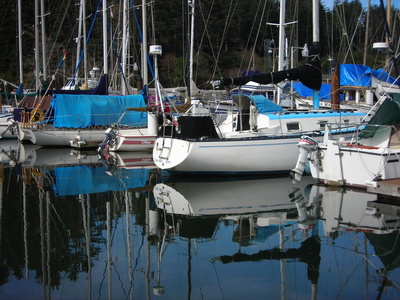
Sometimes it becomes necessary to add a transom bracket to a small sailboat for the addition of an auxiliary "kicker" motor. Small power boats can benefit from a kicker motor when the main engine fails. Some boat owners might want to swap their existing transom bracket to add more extension to their outboard motor, or to refit a stronger bracket for an engine swap. Whatever the reason, transom brackets should be of good quality, be corrosion-resistant and be able to withstand torque and flex.
Mix a solution of dish washing soap and water in a bucket. Thoroughly wash the inside and outside of the transom with a sponge. Remove all oil, algae, water film and dirt. Rinse with a hose. Dry the surfaces completely with towels.
Obtain a transom bracket suited to your engine. The bracket size, width and thickness will depend on the size and horsepower rating of your engine. Determine if an aluminum transom bracket will suffice for a smaller auxiliary engine, or if you will need a stainless-steel version to replace original equipment. A marine supply store will help you with the selection, based on the size and make of your engine, along with the model, style and length of your vessel.
Determine the area on the transom where the bracket will fit. For a center-line bracket, measure the width of the transom and mark the center line. Divide the width of the bracket in half and mark the outside edges on the transom exterior on both sides of the center line with a felt pen. Mark the bottom side of the transom bracket on the transom with a felt pen.
Mark the bracket location on the transom for an auxiliary engine bracket location. This bracket will be mounted off the center line. Make sure the turning radius of the auxiliary engine will not impede the turning radius of the main engine. Be certain the auxiliary engine propeller will sit below the waterline at the correct depth, by noting the distance of the engine mount holes down to the water's surface.
Set your bracket against the outside of the transom and mark the drill holes with a felt pen. Drill through the transom with the correct size bit, as indicated in the kit instructions. Be certain the bracket will not cover up any transom hardware or accessories, and that nothing will be damaged when drilling through the transom. Apply a large bead of adhesive silicon around the perimeter of the bracket and place it on the transom, aligning the drill holes.
Fit the mounting bolts through the transom, using a spacer on the outside bolt head and the proper lock washer, spacer and nut on the inside of the transom. Tighten the bolts firmly and evenly with a socket and wrench. If the kit comes with an inside support plate, make sure it goes on with some silicon adhesive and then the lock washer, spacer and nut.
Add a stock piece of 3/4-inch marine plywood to the inside surface of the transom, and an outer piece of stainless-steel plate. This will serve as a backing plate for added strength, and provide extra support in case your bracket kit does not have these items. Mark the two pieces to align with the bracket holes and drill them out with the drill motor and bit. Use silicone adhesive to glue the plywood to the inside of the transom, and then add the stainless-steel plate over it. Set the bracket in place, run the mounting bolts through it and tighten it with a socket and wrench.